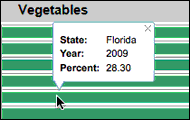
A new report from the Centers for Disease Control says Americans are falling short when it comes to how many fruits and vegetables they include in their diets.
Nationwide, 32.5 percent of U.S. adults consumed the recommended amount of fruit and 26.3 the suggested number of vegetable servings in 2009. These numbers fall way below the government's Healthy People 2010 goal to get 75 percent fitting in 2 servings of fruit and 50 percent 3 helpings of vegetables day-to-day.
The study, which used data from the Behavioral Risk Factor Surveillance System (BRFSS) survey, found that Americans have been passing on the fruits and vegetables for at least the last decade. Researchers compared fruit and vegetable eating rates from 2000 to 2009 and found the numbers have remained fairly static, although both fruit and vegetable consumptions saw slight declines. The percentage of Americans eating their recommended fruit servings decreased by two percent, and vegetables by slightly more than one percent.
In a state-by-state analysis, certain states did better than others, but no state met the government's Healthy People 2010 goals. Washington, D.C. had the highest rate of people eating their fruit servings in 2009 with 40.2 percent, followed closely by California at 40.1. Tennessee was at the top of the list for vegetable serving consumption at 33 percent, followed by Washington, D.C. at 32.3.
But it was not all good news for states with the highest rates. The numbers still fell way below the Healthy People 2010 goals, and some of the states with the best rates of fruit and vegetable consumption also saw the biggest declines from 2000 to 2009. Tennessee saw a 10 percentage point decline in the number of people consuming vegetables even though it was the top state on the list.
The states with the lowest percentage of people eating their fruits and veggies were Oklahoma for fruits at 18.1 percent, and South Dakota for vegetables at 19.1. Use the interactive graph below to see how your state measures up:
Broken down by other demographics, the study showed some interesting trends:
- More women than men ate their fruits and vegetables.
- Seniors ages 65 and up consumed more than people under 65.
- College grads ate substantially more than those without a degree.
- Hispanics consumed more fruit than other racial or ethnic groups, but the least amount of veggies.
- Households with an annual income of $50,000 or greater ate more than lower earning households.
- Fit people with low body mass indexes ate the more fruits and vegetables than overweight and obese Americans.
Nutrition is one of 20 key indicators of health and health care identified by the Institute of Medicine for the State of the USA. (See From Hundreds of Health Measures, 20 Seen as Key.) The study states that a "diet high in fruits and vegetables can reduce the risk for many leading causes of death and can play an important role in weight management."
Suzette Lohmeyer is a staff writer and producer for State of the USA.
Data visualization by Anthony Calabrese, a State of the USA Web producer.
 Print This
Print This RSS Feed
RSS Feed